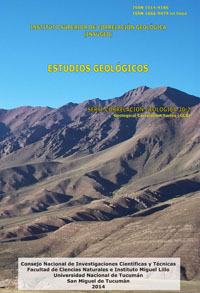Serie Correlación Geológica 30 (2)
El Granito Los Ratones como posible fuente de flúor en la formación de sistemas epitermales, Sierra de Fiambalá, Catamarca.
Mauro De La Hoz | Jorge E. Coniglio | Alicia Kirschbaum
Descargar trabajo en formato PDFResumen
EL GRANITO LOS RATONES COMO POSIBLE FUENTE DE FLÚOR EN LA FORMACIÓN DE SISTEMAS EPITERMALES, SIERRA DE FIAMBALÁ, CATAMARCA. En la presente contribución se efectúa un estudio sistemático del plutón granítico Los Ratones (PLR) y otras rocas aflorantes en el área, para evaluar su potencial como fuente de flúor para la formación de sistemas hidrotermales de baja temperatura. El trabajo está basado en datos de química de roca total y petrografía y compara el contenido de flúor de PLR con el de otros plutones graníticos. El contenido de F en roca total del PLR varía desde 500 hasta 8100 ppm, con un promedio de 3825 ppm. Comparando el PLR con otros cuerpos de características similares de Argentina y Brasil, se puede observar que la evolución metalogenética no fue simplemente consecuencia de la cristalización de un magma, sino de múltiples eventos hidrotermales. Esta evolución metalogenética es una característica destacada de los llamados granitos HHP (high heat production), dada por los relativamente elevados contenidos en K, Th y U. Las evidencias de campo, mineralógicas y geoquímicas encontradas hasta el momento sugieren que el PLR también se podría situar dentro de esta categoría de granitos HHP. Varios autores han planteado que los granitos HHP podrían aportar F, U y otros metales para las mineralizaciones epitermales postplutónicas y generar convección hidrotermal conducida por una fuente local de calor radiogénico, generada por la desintegración de U, Th y K. Las aguas termales que surgen del granito Los Ratones atestiguan el dinamismo de este ambiente y probablemente sean la evidencia actual de paleosistemas hidrotermales complejos, polifásicos, sobreimpuestos, con más de 280 Ma de evolución tectónica y térmica, asociados con granitos de alta producción de calor.
Abstract
THE LOS RATONES GRANITE AS POSSIBLE SOURCE OF FLUORINE IN THE FORMATION OF EPITHERMAL SYSTEMS, SIERRA DE FIAMBALÁ, CATAMARCA. In the present contribution it is given to know a systematic study of the Los Ratones granite pluton (LRP) and the rocks that outcropping in the surrounding
area in order to evaluate its potential as Fluorine (F) source in the formation of low-temperature hydrothermal systems. This work is based on total rock geochemistry and petrography studies, it also compare the F content of PLR with other similar granitic plutons.The F content in PLR varies between 500 and 8100 ppm, with an average of 3825 ppm. In comparison with other similar plutons from Argentina and Brasil, the PLR metallogenetic evolution was not only related to magma crystallization, but also to several hydrothermal events. This kind of metallogenetic evolution is a typical feature of High Heat Production (HHP) granites, and it is given by the relatively high K, Th and U contents. Field features, mineralogical and geochemistry evidence suggest that LRP could be classified as HHP-Type granite. Many authors propose that HHP granites could be the source of F, U and other metals in the epithermal post-plutonic mineralization, and could generate hydrothermal convection driven by a local source of radiogenic heat by U, Th and K disintegration. The hot springs that emerge from the LRP at the present are the evidence of this environmental dynamism. They probably are the current witness of complex hydrothermal paleosystems that were superimposed during the last 280 Ma of tectonic and thermal evolution associated with this kind of high heat production granites.






